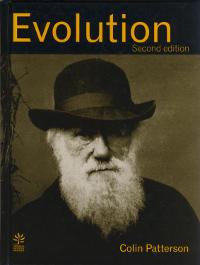Colin Patterson, Evolution, Second Edition

A review by Gert Korthof
8 Dec 2013
Updated: 1 Aug 2023
Colin Patterson (1999) "Evolution, Second Edition",
The Natural History Museum, London. hardback, 166 pages.
Paperback edition: NHM (1998) (1).
US edition: Cornell Press.
Many illustrations.
From the Preface to the First edition (1978):
"In writing this book I tried to produce an account of modern evolutionary theory which does not beg too many questions, and is complete enough to be coherent but simple enough to comprehensible to those with little of no technical knowledge of biology."
From the Preface to the Second edition (1999):
"The knowledge in my first edition came from education and indoctrination; it was that neo-Darwinism is certainty. The knowledge in this second edition comes more from working things out for myself; it is that evolution is certainty. And part of the ignorance in the first edition concerned the difference between neo-Darwinism and evolution, whereas the ignorance in this edition is of the completeness of neo-Darwinism as an explanation of evolution.
To learn the differences between neo-Darwinism and evolution you may prefer to read on, but evolution is about what Darwin called 'descent with modification'– it concerns the idea of common or shared ancestry and the belief that all species are related by descent. I think that belief is now confirmed as completely as anything can be in the historical sciences. Neo-Darwinism concerns the explanation of descent with modification, and it emphasizes Darwin's own main contribution, natural selection. I am no longer certain that natural selection is the complete explanation, and I hope the new edition contains enough information, and not too much bias, for readers to understand the problem and judge the answers themselves."
Chapter 12 gives a detailed but readable account of the species and speciation on the Galapagos islands.
Chapter 13 is about 'The hierarchy of life' (including classification, but 'cladism' or 'cladistics' is not in the index).
Chapter 14 is about the philosophy of science: Science versus pseudo-science, Is evolution science? Alternative theories, A metaphysical research programme? Science and politics.
Patterson and creationism
Several important things happened between the first (1978) and second edition (1999):
- in 1981 The Natural History Museum, London, opened a new exhibit on the 'Orgin of Species';
- in March 1981 the State of Arkansas signed into law the 'Balanced treatment for creation-science and evolution-science Act';
- a prolonged discussion in the pages of Nature about classification methods in evolutionary biology, creation science, and the NHM exhibit
- In 1981 Patterson lectured at the American Museum of Natural History (2). His talk was secretly recorded by creationist Luther Sunderland (6)
- In 1988 Phillip Johnson discussed evolution with Colin Patterson for several hours in London (3)
- In 1991 the first edition of Phillip Johnson's Darwin on Trial appeared
Patterson is quoted several times by Intelligent Design lawyer Phillip E. Johnson in his anti-evolution Darwin on Trial (4) for obvious reasons: casting doubt on the reality of evolution.
However, after the first edition, Patterson witnessed that "evolutionary theory being brought into the courtroom and the polling booth by creationists" (5), he wrote in the second edition: "evolution is certainty" and expressed doubts about "the completeness of neo-Darwinism as an explanation of evolution". Patterson is certainly not the only biologist expressing doubt about the completeness of neo-Darwinism. The reason is obvious: neo-Darwinism is incomplete because knowledge of the mechanisms of evolution is increasing all the time. In 1999 neo-Darwinism was certainly incomplete. For example, the 'evo-devo' revolution was just about to start. Incompleteness does not mean that neo-Darwinism is wrong, but simply it is incomplete just as every scientific theory. In other words: evolutionary biologists are busy constructing 'The Third Evolutionary Synthesis'.
Non-coding DNA and junk DNA
In chapter 10 'Gene families and gene evolution' the story of the haemoglin family of genes is told. On the DNA level several inactive (processed) pseudogenes and other non-coding DNA such as repetitive DNA (ALU, LINE, SINE) are found between the different haemoglobin genes. In paragraph 10.4 Junk DNA, selfish DNA or ignorant DNA are discussed.
Symbiosis
Patterson describes symbiosis in detail (15.4 The origin of eukaryotes, pages 131-134). Besides mitochondria and chloroplasts, he also discusses the origin of flagella and cilia.
Notes
- See for sample pages the NHM page.
- Phillip Johnson (1993) Darwin on Trial, p. 9.
- Phillip Johnson (1993) Darwin on Trial, p. 173
- See my review of Darwin on Trial, Postscripts 2. Please note the title: 'Darwin on trial', not: 'evolution on trial'!
- In the Preface to the Second Edition of Evolution, page vii.
- Donald R. Prothero (2007) Evolution: What the Fossils Say and Why It Matters, hardback Columbia University Press, p. 135. Please read: 'The Cladistic Revolution' p. 127–135.
Reviews
- Karen Bartelt (2000), Evolution, Reports of the National Center for Science Education, Volume 20 (2000)
Further Reading
|



